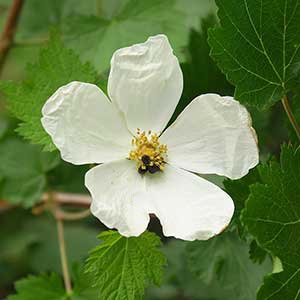Rubus bartonianus
Rubus hispidus
Barton's raspberry, bartonberry
bristly blackberry, bristly dewberry, ronce hispide, swamp dewberry
erect, sparsely short-hairy, glabrescent, eglandular, not pruinose.
biennial, creeping, tip-rooting, flowering branches often erect, glabrous or sparsely hairy, sparsely to densely short- to long-stipitate-glandular, rarely eglandular, not pruinose;
prickles sparse to dense, erect to retrorse, weak, slender, 1–3(–5) mm, narrow-based;
bristles sparse to dense, erect or retrorse, narrow, flexible and weak, not gland-tipped.
deciduous, simple;
stipules lanceolate, 4–6 mm;
blade cordate to broadly ovate, (2–)2.5–4(–5) × (2.5–)3.5–4.5(–5.5) cm, base deeply cordate, 3–5-lobed, lobe apices acute to obtuse, margins coarsely doubly dentate, abaxial surfaces glabrous or sparsely hairy, eglandular or sparsely stipitate-glandular.
persistent, ternate or, rarely, palmately compound, lustrous;
stipules linear to narrowly lanceolate, (2–)5–15(–20) mm;
leaflets 3(–5), terminal obovate to suborbiculate, 1.7–6.5 × 1–5.2 cm, base cuneate to rounded, unlobed, margins moderately to coarsely doubly serrate, apex acute to rounded, abaxial surfaces with bristles on midvein or unarmed, glabrous or sparsely hairy, sparsely to densely short-stipitate-glandular along largest veins.
1-flowered.
terminal on short shoots, usually appearing axillary, 1–7(–10)-flowered, racemiform.
moderately hairy, eglandular or sparsely stipitate-glandular.
unarmed or bristles moderate to sometimes dense, erect to retrorse, moderately to densely hairy, sparsely to densely short- to long-stipitate-glandular.
bisexual;
petals white, obovate, (15–)20–25 mm;
filaments filiform;
ovaries glabrous, styles clavate, villous.
bisexual;
petals white, obovate to oblanceolate, 6–10 mm;
filaments filiform;
ovaries glabrous.
deep red, hemispheric, to 1 cm;
drupelets 10–30, coherent, separating from torus.
black, globose to cylindric, to 1 cm;
drupelets (5–)10–15(–20), strongly coherent, separating with torus attached.
= 14, 21, 28, 35, 56.
Rubus bartonianus
Rubus hispidus
Of conservation concern.
Rubus bartonianus is distinguished from the other flowering raspberries within its geographic range by its erect, unarmed stems, relatively small, simple leaves with acute to obtuse lobes, deeply cordate bases, sparsely hairy or glabrous abaxial surfaces, relatively large flowers with white petals, and densely long-hairy, clavate styles. The leaves superficially resemble those of Acer glabrum or some species of Ribes.
Rubus bartonianus is most similar to R. neomexicanus but especially R. deliciosus. The species is known only from the Snake River Canyon of Idaho and Oregon.
(Discussion copyrighted by Flora of North America; reprinted with permission.)
Rubus hispidus is identified mostly by its creeping primocanes with somewhat lustrous, coriaceous, and relatively small leaves that persist for nearly a year, and an armature of stiff hairs or, rarely, weak, slender prickles. Plants with few persistent leaves may be evidence of introgression with R. flagellaris or R. setosus. Hybrids with R. cuneifolius have been seen around abandoned commercial cranberry bogs in New Jersey (G. Moore, pers. obs.). The superficially similar R. caesius differs from R. hispidus in its pruinose stems, deciduous and non-lustrous leaves, and pruinose fruit.
Rubus hispidus is introduced in southwestern Washington State.
The following nothospecies names are based on putative hybrids involving Rubus hispidus and: R. canadensis (R. ×novanglicus L. H. Bailey); R. flagellaris (R. ×ambigens Fernald, R. ×distinctus L. H. Bailey, R. ×elongatus Brainerd & Peitersen [not R. elongatus Smith], R. ×emeritus L. H. Bailey, R. ×furtivus L. H. Bailey, R. ×kalamazoensis L. H. Bailey, R. ×permixtus Blanchard, R. ×rosendahlii L. H. Bailey, R. ×segnis L. H. Bailey, R. ×varus L. H. Bailey, R. ×vigoratus L. H. Bailey); R. setosus (R. ×adjacens Fernald, R. ×grandidens L. H. Bailey, R. ×harmonicus L. H. Bailey, R. ×jacens Blanchard, R. ×parlinii L. H. Bailey, R. ×spiculosus Fernald, R. ×tardatus Blanchard, R. ×tholiformis Fernald, R. ×trifrons Blanchard, R. ×zaplutus L. H. Bailey).
(Discussion copyrighted by Flora of North America; reprinted with permission.)


